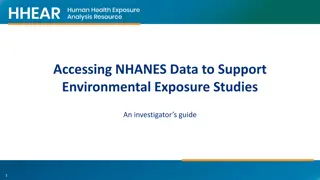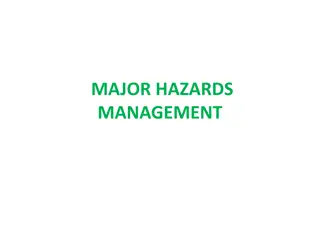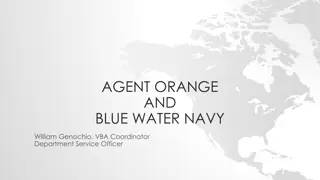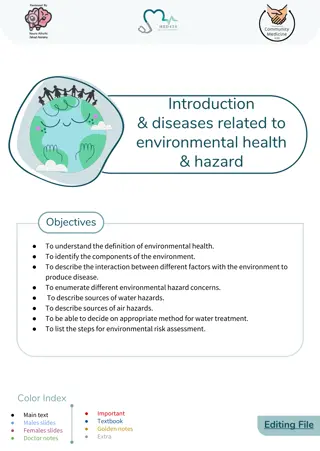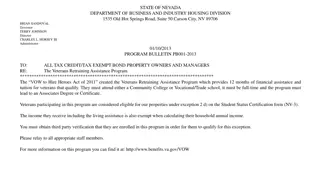Environmental Hazards Faced by Veterans and Agent Orange Exposure Locations
Veterans may have been exposed to a variety of environmental hazards during their military service, including Agent Orange-related diseases, Gulf War illnesses, radiation-related diseases, traumatic brain injury, and more. Agent Orange exposure locations include Vietnam, C-123 airplanes, Blue Water Veterans, Korean Demilitarized Zone, Thailand military bases, and areas where Air Force members served on C-123 aircraft. Understanding these hazards and exposure locations is crucial for supporting veterans' health and well-being.
Download Presentation

Please find below an Image/Link to download the presentation.
The content on the website is provided AS IS for your information and personal use only. It may not be sold, licensed, or shared on other websites without obtaining consent from the author.If you encounter any issues during the download, it is possible that the publisher has removed the file from their server.
You are allowed to download the files provided on this website for personal or commercial use, subject to the condition that they are used lawfully. All files are the property of their respective owners.
The content on the website is provided AS IS for your information and personal use only. It may not be sold, licensed, or shared on other websites without obtaining consent from the author.
E N D
Presentation Transcript
Indiana Department of Veterans Affairs
Environmental Hazards Veterans may have been exposed to a range of chemical, physical, and environmental hazards during military service.
Environmental Hazards AGENT ORANGE RELATED DISEASES GULF WAR ILLNESSES RADIATION RELATED DISEASES TOXIC EMBEDDED FRAGMENTS TRAMATIC BRAIN INJURY COLD INJURIES BIRTH DEFECTS INFECTIOUS DISEASES VACCINATIONS AND MEDICATIONS DURING SERVICE RABIES HEAT INJURIES OCCUPATIONAL HAZARDS 3
AGENT ORANGE AL Amyloidosis Chronic B-cell Leukemias Chloracne Diabetes Mellitus Type 2 Hodgkin's Disease Ischemic Heart Disease Multiple Myeloma Non-Hodgkin's Lymphoma Parkinson's Disease Peripheral Neuropathy, Early- Onset Porphyria Cutanea Tarda Prostate Cancer Respiratory Cancers(includes lung cancer) Soft Tissue Sarcomas
LOCATIONS OF AGENT ORANGE EXPOSURE Exposure to Agent Orange in Vietnam C-123 Airplanes and Agent Orange Residue Blue Water Veterans U.S. Navy and Coast Guard Ships in Vietnam Korean Demilitarized Zone Thailand Military Bases Herbicide Tests and Storage Outside Vietnam
LOCATIONS (CONT) In addition, VA has determined there is evidence of exposure to Agent Orange for Air Force and Air Force Reserve members who served: during the period 1969 through 1986 regularly and repeatedly operated, maintained, or served onboard C-123 aircraft Agent Orange C-123 web page Exception: Blue Water Veterans with non-Hodgkin's lymphoma may be granted service-connection without showing inland waterway service or that they set foot in Vietnam. BLUE WATER/US COAST GUARD In Vietnam anytime between: January 9, 1962 and May 7, 1975. Including brief visits ashore. Service aboard a ship that operated on the inland waterways of Vietnam. (U.S. Navy and Coast Guard ships that operated in Vietnam ) Korean demilitarized zone between April 1, 1968 and August 31, 1971 6
LOCATIONS (CONT) Thailand Military Bases and Agent Orange Exposure U.S. Air Force Veterans who served on Royal Thai Air Force (RTAF) bases at U-Tapao, Ubon, Nakhon Phanom, Udorn, Takhli, Korat, and Don Muang, near the air base perimeter anytime between February 28, 1961 and May 7, 1975. U.S. Army Veterans who provided perimeter security on RTAF bases in Thailand anytime between February 28, 1961 and May 7, 1975. U.S. Army Veterans who were stationed on some small Army installations in Thailand anytime between February 28, 1961 and May 7, 1975. However, the Army Veteran must have been a member of a military police (MP) unit or was assigned an MP military occupational specialty whose duty placed him/her at or near the base perimeter. A Department of Defense report (9.3 MB, PDF) written in 1973, Project CHECO Southeast Asia Report: Base Defense in Thailand 1968-1972, contains evidence that there was a significant use of herbicides on the fenced-in perimeters of military bases in Thailand to remove foliage that provided cover for enemy forces.
LOCATIONS(CONT) Herbicidal Tests and locations (per DOD): https://www.publichealth.va.gov/exposures/agentorange/locations/tests- storage/usa.asp INDIANA Location: Vigo Plant CWS, Terre Haute, IN Dates: 5/1945 - 9/1945 Project Description: Small plot experiments were commenced to test the effectiveness of LN agents. Various trials were done under contract with the USDA, aided by personnel at Camp Detrick. Here, it was aerial trials spraying field grown plants. Agents: LN *phenoxy DoD Involvement: Yes Location: Jefferson Proving Grounds, Madison, IN Dates: Summer 1945 Project Description: Small plot experiments were commenced to test the effectiveness of LN agents. Various trials were done under contract with the USDA, aided by personnel at Camp Detrick. Here, it was dropping trials. Agents: LN *phenoxy DoD Involvement: Yes
Birth Defects in Children of Vietnam and Korea Veterans VA has recognized that certain birth defects among Veterans' children are associated with Veterans' qualifying service in Vietnam or Korea. Spina bifida (except spina bifida occulta), a defect in the developing fetus that results in incomplete closing of the spine, is associated with Veterans' exposure to Agent Orange or other herbicides during qualifying service in Vietnam or Korea. Birth defects in children of women Veterans is associated with their military service in Vietnam, but are not related to herbicide exposure.
Birth Defects in Children of Vietnam and Korea Veterans (Covered birth defects include, but are not limited to, the following conditions:) Achondroplasia Cleft lip and cleft palate Congenital heart disease Congenital talipes equinovarus (clubfoot) Esophageal and intestinal atresia Hallerman-Streiff syndrome Hip dysplasia Hirschprung's disease (congenital megacolon) Hydrocephalus due to aqueductal stenosis Hypospadias Imperforate anus Neural tube defects Poland syndrome Pyloric stenosis Syndactyly (fused digits) Tracheoesophageal fistula Undescended testicle Williams syndrome Conditions due to family disorders, birth-related injuries, or fetal or neonatal infirmities with well-established causes are not covered. If any of the birth defects listed above are determined to be a family disorder in a particular family, they are not covered birth defects.
BIRTH DEFECTS Lou Gehrig's Disease: (amyotrophic lateral sclerosis or ALS) diagnosed in all Veterans who had 90 days or more continuous active military service is related to their service, although ALS is not related to Agent Orange exposure.
GULF WAR Gulf War service is active military duty in any of the following areas in the Southwest Asia theater of military operations at any time August 2, 1990 to present. This includes Veterans who served in Operation Iraqi Freedom (2003-2010) and Operation New Dawn (2010-2011)
GULF WAR ILLNESS (LOCATIONS) Iraq Kuwait Saudi Arabia The neutral zone between Iraq and Saudi Arabia Bahrain Qatar The United Arab Emirates (U.A.E.) Oman Gulf of Aden Gulf of Oman Waters of the Persian Gulf, the Arabian Sea, and the Red Sea The airspace above these locations
GULF WAR ILLNESSS CHRONIC MULTISYMPTOM ILLNESS (Gulf War Syndrome) A prominent condition affecting Gulf War Veterans is a cluster of medically unexplained chronic symptoms that can include fatigue, headaches, joint pain, indigestion, insomnia, dizziness, respiratory disorders, and memory problems. Symptoms vary widely! Certain chronic, unexplained symptoms are related to Gulf War service without regard to cause. : Existing for 6 months or more Must have appeared during active duty Before December 31, 2021 At least 10 percent disabling.
GULF WAR ILLNESSS Functional gastrointestinal disorders, a group of conditions marked by chronic or recurrent symptoms related to any part of the gastrointestinal tract. Functional condition refers to an abnormal function of an organ, without a structural alteration in the tissues. Examples include irritable bowel syndrome (IBS), functional dyspepsia, and functional abdominal pain syndrome. Myalgic Encephalomyelitis/Chronic Fatigue Syndrome (ME/CFS), a condition of long-term and severe fatigue that is not relieved by rest and is not directly caused by other conditions. Fibromyalgia, a condition characterized by widespread muscle pain. Other symptoms may include insomnia, morning stiffness, headache, and memory problems
GULF WAR ILLNESSS Undiagnosed illnesses with symptoms that may include but are not limited to: Neurological and psychological problems Skin conditions Respiratory disorders Sleep disturbances. Abnormal weight loss Fatigue Cardiovascular disease Muscle and joint pain Headache Menstrual disorders
GULF WAR ILLNESSS (INFECTIOUS DISEASES) Veterans must have the diseases within the time frames shown below and have a current disability as a result of that disease in order to receive disability compensation. Malaria An infectious disease caused by a parasite transmitted by mosquitoes. Symptoms include chills, fever, and sweats. It must be at least 10 percent disabling within one year from the date of military separation or at a time when standard or accepted treatises indicate that the incubation period began during a qualifying period of military service. Brucellosis A bacterial disease with symptoms such as profuse sweating and joint and muscle pain. The illness may be chronic and persist for years. It must be at least 10 percent disabling within one year from the date of military separation. Campylobacter Jejuni A disease with symptoms such as abdominal pain, diarrhea, and fever. It must be at least 10 percent disabling within one year from the date of military separation. Coxiella Burnetii (Q Fever) A bacterial disease with symptoms such as fever, severe headache, and gastrointestinal problems such as nausea and diarrhea. In chronic cases, the illness may cause inflammation of the heart. It must be at least 10 percent disabling within one year of the date of military separation.
GULF WAR ILLNESSS (INFECTIOUS DISEASES) Mycobacterium Tuberculosis An illness that primarily affects the lungs and causes symptoms such as chest pain, persistent cough (sometimes bloody), weight loss and fever. Nontyphoid Salmonella A condition characterized by symptoms such as nausea, vomiting, and diarrhea. It must be at least 10 percent disabling within one year of the date of military separation. Shigella A condition characterized by symptoms such as fever, nausea, vomiting, and diarrhea. It must be at least 10 percent disabling within one year of the date of military separation. Visceral Leishmaniasis A parasitic disease characterized by symptoms such as fever, weight loss, enlargement of the spleen and liver, and anemia. The condition may be fatal if left untreated. West Nile Virus A disease spread by mosquitoes characterized by symptoms such as fever, headache, muscle pain or weakness, nausea, and vomiting. Symptoms may range from mild to severe. It must be at least 10 percent disabling within one year from the date of military separation.
Vaccinations and Gulf War Veterans The Health and Medicine Division (formally known as the Institute of Medicine) of the National Academy of Sciences, Engineering, and Medicine concluded in its report Gulf War and Health: Depleted Uranium, Sarin, Pyridostigmine Bromide, and Vaccines (2000) that there is inadequate or insufficient evidence to determine whether an association does or does not exist between multiple vaccinations and long-term adverse health problems.
Vaccinations and Gulf War Veterans VA and research organizations continue to evaluate possible causes of Gulf War Veterans' chronic multisymptom illnesses, including vaccinations. Standard series of inoculations against infectious diseases provided to any U.S. citizen traveling to the Gulf (including yellow fever, typhoid, cholera, hepatitis B, meningitis, whooping cough, polio, tetanus) Anthrax - about 150,000 troops Botulinum toxoid - about 8,000 troops
Pyridostigmine Bromide (Nerve Agent) VA and research organizations evaluated exposure to pyridostigmine bromide (PB), an anti-nerve agent pill Gulf War Veterans may have taken during military service, as a possible cause of chronic multisymptom illnesses. VA has concluded that the evidence does not support an association.
Oil Well Fires Between February to November 1991, Iraqi armed forces ignited oil well fires, producing dense clouds of soot, liquid, aerosols and gases Plumes of billowing smoke remained low to the ground, in some areas enveloping U.S. military personnel Exposures were highest during wintertime encampments in Saudi Arabia Particles from oil well fires may cause skin irritation, runny nose, cough, shortness of breath; eye, nose, and throat irritation; and aggravation of sinus and asthma conditions. Most of the irritation is temporary and resolves once the exposure is gone. Research does not show evidence of long-term health problems from exposure to oil well fires at this time.
Pesticides Pesticides used in the Gulf War fall into several major categories: Methyl carbamate organochlorine pesticides (lindane), used to treat uniforms DEET, used on the skin as an insect repellent Organophosphorus (OP) pesticides Pyrethroid pesticides (primarily permethrin) Lindane and DEET were used as personal insect repellents, lindane to treat uniforms and DEET on the skin. All other pesticides shipped to the Gulf region were to be used only by specially trained individuals or for specific applications. VA evaluated pesticide exposure as a possible cause of Gulf War Veterans' chronic multisymptom illnesses and concluded that research does not support an association currently.
Chemical and Biological Weapons Khamisiyah, Iraq chemical storage demolition: Rockets filled with sarin and cyclosporine mixes were found at a munitions storage depot in Khamisiyah, Iraq that had been demolished by U.S. Servicemembers following the 1991 Gulf War cease-fire. An undetermined amount of these chemicals was released into the atmosphere. The Department of Defense concluded about 100,000 Gulf War Veterans could have been exposed to low-levels of these nerve agents. https://www.publichealth.va.gov/exposures/gulfwar/sources/chem-bio- weapons.asp
Sand, Dust, and Particles Veterans who were deployed to the Persian Gulf, Afghanistan and other dusty environments were often exposed to sand, dust, pollution and other airborne particles. Larger particles such as sand may become trapped in the nose and throat but can be expelled by coughing or sneezing. Very small, fine particles (particulates) may cause more serious health problems because they can be inhaled deep into the lungs and airways. These extremely small particles and liquid droplets can include acids, chemicals, metals, soil or dust. Join the Airborne Hazards and Open Burn Pit Registry to create a snapshot of your health and help us learn more about potential health effects.
Particulate matter pollution in Iraq and Afghanistan Particulate Matter (PM) levels in Southwest Asia are naturally higher. Primary sources of PM in Southwest Asia include: dust storms vehicle exhaust construction sites farming emissions from local industries.
The use of burn pits for waste management increased the naturally high concentrations of PM in Iraq and Afghanistan. Air sampling performed at Joint Base Balad, Iraq (the large Balad burn pit operated there and was shut down in 2009) detected increased particulate matter and infrequently some chemicals, which may have been due to the industry in Iraq.
Naval Air Facility in Atsugi, Japan From 1985 to 2001, personnel at Naval Air Facility (NAF) Atsugi in Atsugi, Japan were exposed to environmental contaminants from an off-base waste incinerator. Learn more about the Atsugi waste incinerator chemical emissions and the investigation of health effects. Atsugi, Japan is not included in the list of eligible locations for the Airborne Hazards and Open Burn Pit Registry. https://www.publichealth.va.gov/exposures/sand-dust- particulates/atsugi.asp Short-term health effects could include irritation to the eyes, nose and throat, skin rashes, and sinus problems. These conditions usually went away after the exposure ended. Long-term health effects could include a possible increase in the lifetime risk for cancer.
Depleted Uranium The U.S. military uses tank armor and some bullets made with depleted uranium (DU) to penetrate enemy armored vehicles, and began using DU on a large scale during the Gulf War. The process of manufacturing enriched uranium from natural uranium used in nuclear reactors or weapons leaves "depleted" uranium. DU has 40 percent less radioactivity, but the same chemical toxicity as natural uranium.
Depleted Uranium When a projectile made with DU penetrates a vehicle, small pieces of DU can scatter and become embedded in muscle and soft tissue. In addition to DU in wounds, Service members exposed to DU in struck vehicles may inhale or swallow small airborne DU particles. Some Gulf War, Bosnia, Operation Enduring Freedom (OEF), Operation Iraqi Freedom (OIF), and Operation New Dawn (OND) Veterans who may have been exposed to DU are those who were: on, in or near vehicles hit with friendly fire entering or near burning vehicles near fires involving DU munitions or salvaging damaged vehicles
Depleted Uranium (Health Issues) DU is a potential health hazard if it enters the body, such as through: Embedded Fragments Contaminated wounds Inhalation or ingestion. So far no health problems associated with DU exposure have been found in Veterans exposed to DU. Researchers and clinicians continue to monitor the health of these Veterans. Simply riding in a vehicle with DU weapons or DU shielding WILL NOT cause significant exposure. The potential for health effects from internal exposure is related to the amount of DU that enters a person s body. If DU enters the body, it may remain in the body. Studies show high doses may especially affect the kidneys. https://www.publichealth.va.gov/exposures/depleted_uranium/followup_program.asp
RADIATION RELATED EXPOSURE Two broad types of radiation Non-ionizing and ionizing. Ionizing radiation sends out extremely high energy, which may pose a health risk. Ionizing radiation exposure comes from a variety of sources, including nuclear weapons testing or other activities during military service.
Diseases associated with Radiation Exposure For Veterans who participated in a radiation-risk activity during service (including "Atomic Veterans"), VA assumes that certain cancers are related to their exposure. These Veterans DON T have to prove a connection between these diseases and their service to be eligible for disability compensation. Survivors could be eligible for benefits.
Diseases associated with Radiation Exposure PRESUMTIVE CANCERS: Cancers of the bile ducts, bone, brain, breast, colon, esophagus, gall bladder, liver (primary site, but not if cirrhosis or hepatitis B is indicated), lung (including bronchiolo-alveolar cancer), pancreas, pharynx, ovary, salivary gland, small intestine, stomach, thyroid, urinary tract (kidney/renal, pelvis, urinary bladder, and urethra) Leukemia (except chronic lymphocytic leukemia) Lymphomas (except Hodgkin s disease) Multiple myeloma (cancer of plasma cells)
Diseases associated with Radiation Exposure The following diseases are POSSIBLY caused by exposure to ionizing radiation during service: VA also will consider the possibility that other diseases, not listed, were caused by radiation, if supported by medical or scientific evidence. All cancers Non-malignant thyroid nodular disease Parathyroid adenoma Posterior subcapsular cataracts Tumors of the brain and central nervous system Eligibility for disability compensation or survivors' benefits depends on how much radiation the Veteran received and other factors, such as the period of time between exposure to radiation and the development of the disease. VA decides these claims on a case-by-case basis. AT LEAST AS LIKELY AS NOT
RADIATION-RISK ACTIVITY "Atomic Veterans," an unofficial term that refers to Veterans who: Participated in the occupation of Hiroshima and Nagasaki, Japan between Aug. 6, 1945 and July 1, 1946 Were prisoners of war in Japan during World War II Participated in atmospheric nuclear weapons tests conducted primarily in Nevada and the Pacific Ocean between 1945 and 1962 Read fact sheets on the tests from the Nuclear Test Personnel Review office. http://www.dtra.mil/Home/Nuclear-Test-Personnel-Review/NTPR-Fact-Sheets/
RADIATION-RISK ACTIVITY Veterans who participated in underground nuclear weapons testing at: Amchitka Island, Alaska before Jan. 1, 1974 One of the following gaseous diffusion plants for at least 250 days before Feb. 1, 1992: Paducah, Kentucky; Portsmouth, Ohio; or K25 in Oak Ridge, Tennessee. Ionizing Radiation Registry health exam
Exposure to Radiation Veterans who served in any of the following situations or circumstances may have been exposed to radiation: U.S. Air Force plutonium clean-up mission, Palomares, Spain A nuclear weapons mishap occurred on January 17, 1966, over Palomares, Spain, when a United States Air Force (USAF) B-52 bomber and KC-135 tanker aircraft collided. The mishap led to the release of four nuclear weapons. Two of the weapons were damaged when they hit the ground and released plutonium, a radioactive material. There was no nuclear detonation. During the response, approximately 1,600 military and civilian personnel were potentially exposed to airborne dust and debris contaminated with plutonium. Fukushima nuclear accident Servicemembers may have been exposed to low doses of radiation in Japan from March 12 to May 11, 2011, following a nuclear accident on March 11, 2011.
Exposure to Radiation Radiation-risk activity (includes "Atomic Veterans") Activities include participation in nuclear weapons testing and the American occupation of Hiroshima and Nagasaki. Military occupational exposure Various military occupations, such as nuclear weapons technicians and dental technicians, include routine and usually safe exposure to radiation. Depleted uranium During an explosion, pieces of depleted uranium used in tank armor and some bullets can scatter and embed in muscle and soft tissue. LORAN radiation U.S. Coast Guard Veterans who worked at LORAN (Long Range Navigation) stations from 1942 to 2010 may have been exposed to X-ray radiation from high voltage vacuum tubes.
Exposure to Radiation McMurdo Station, Antarctica nuclear power plant The U.S. Navy operated a small nuclear plant at the McMurdo Station, Antarctica, from 1964 to 1973. The nuclear plant was decommissioned after a leak was discovered. Nasopharyngeal (nose and throat) radium irradiation treatments Certain pilots, submariners, divers, and others were given this treatment during service in 1940 to the mid-1960s to prevent ear damage from pressure changes. These Veterans are eligible for a free Ionizing Radiation Registry health exam.


